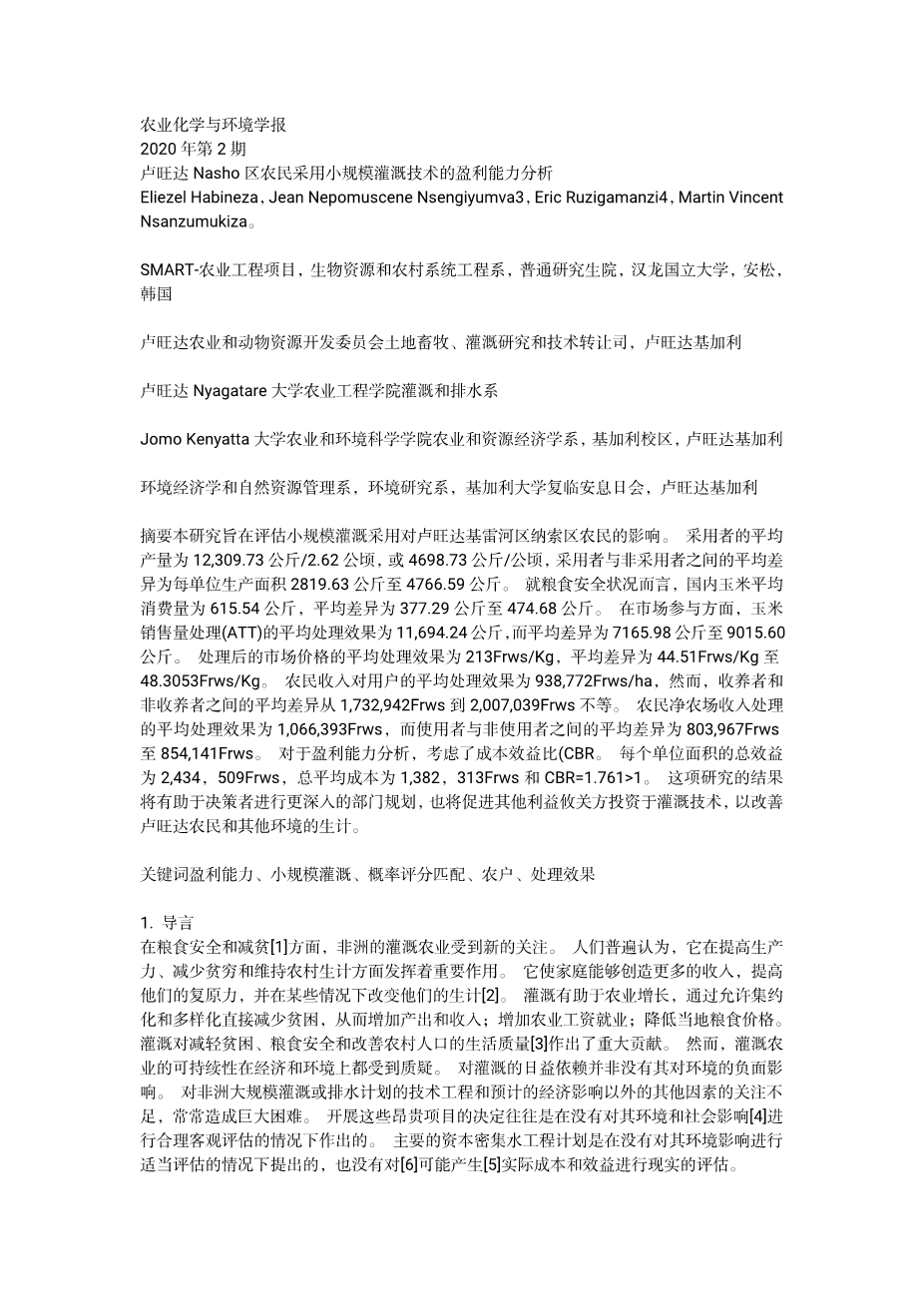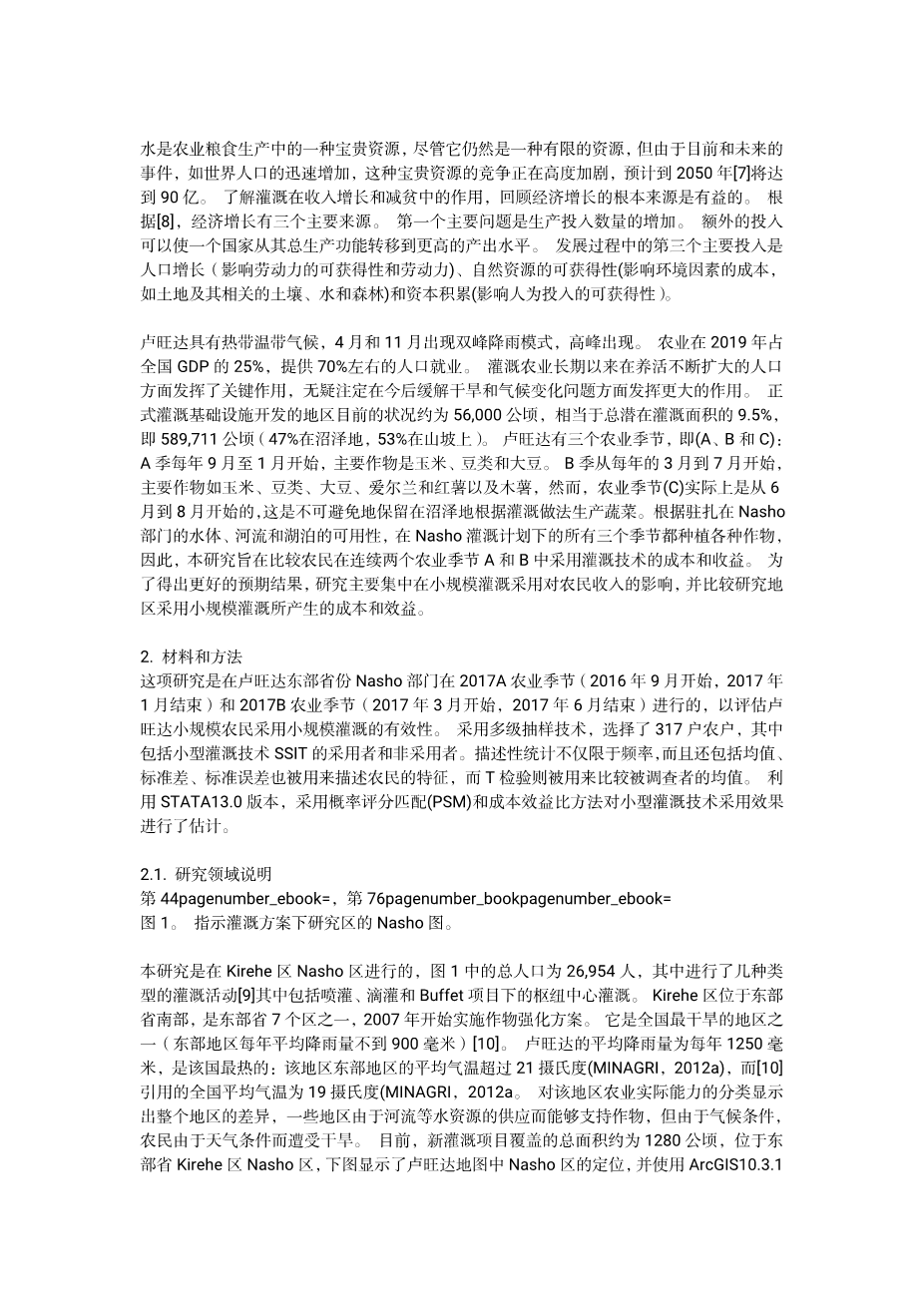Journal of Agricultural Chemistry and Environment
2020年第2期
Profitability Analysis of Small Scale Irrigation Technology Adoption to Farmers in Nasho Sector, Rwanda
Eliezel Habineza, Jean Nepomuscene Nsengiyumva3, Eric Ruzigamanzi4,Martin Vincent Nsanzumukiza.
SMART-Agricultural Engineering Program, Department of Bio-Resources and Rural Systems Engineering, General Graduate School, Hankyong National University, Anseong, South Korea
Department of Land Husbandry, Irrigation Research and Technology Transfer, Rwanda Agriculture and Animal Resources Development Board, Kigali, Rwanda
Department of Irrigation and Drainage, School of Agriculture Engineering, University of Rwanda, Nyagatare, Rwanda
Department of Department of Agricultural and Resources Economics, School of Agriculture and Environmental Sciences,Jomo Kenyatta University, Kigali Campus, Kigali, Rwanda
Department of Environmental Economics and Natural Resources Management, Faculty of Environmental Studies,University of Lay Adventists of Kigali, Kigali, Rwanda
Abstract The study aims to assess the effect of small scale irrigation adoption to farmers in Nasho sector, Kirehe District in Rwanda. The average yield was 12,309.73 Kg/2.62 ha or 4698.73 Kg/ha for adopters with the mean difference between adopters and non adopters ranged from 2819.63 Kg to 4766.59 Kg per unit area of production. For food security status, the average mean quantity of maize consumed at home level was 615.54 Kg with the mean difference ranged from 377.29 Kg to 474.68 Kg. For market participation, the average treatment effect of the treated (ATT) of quantity of maize sold was 11,694.24 Kg while the mean difference ranged from 7165.98 Kg to 9015.60 Kg. The Average Treatment Effect of the Treated market price was 213 Frws/Kg while the mean difference ranged from 44.51 Frws/Kg to 48.3053 Frws/Kg. The Average Treatment Effect of the Treated of farmerrsquo;s revenues for the users was 938,772 Frws/ha, however, the mean difference between adopters and non adopters ranged from 1,732,942 Frws to 2,007,039 Frws. The Average Treatment Effect of the Treated of farmerrsquo;s net farm income was 1,066,393 Frws while mean difference between users and non users ranged from 803,967 Frws to 854,141 Frws. For profitability analysis, the cost benefit ratio (CBR)was taken into account. The total benefit per unit area was 2,434,509 Frws and total average mean cost of 1,382,313 Frws and CBR = 1.761 > 1. The findings of this study will help the policy makers for deeper sector planning and also, it will facilitate other stakeholders to invest in irrigation technology to improve the livelihoods of Rwandan farmers and other surroundings.
Keywords Profitability, Small Scale İrrigation, Propensity Score Matching, Farmers,Treatment Effect
1. Introduction
Irrigated agriculture in Africa is under renewed attention in relation to food security and poverty reduction [1]. It is widely acknowledged to play a major role in improving productivity, reducing poverty and sustaining rural livelihoods. It enables households to generate more income, increase their resilience and, in some cases, transform their livelihoods [2]. Irrigation contributes to agricultural growth and reduces poverty directly through permitting intensification and diversification, hence increased outputs and incomes; increasing agricultural wage employment; and reducing local food prices. Irrigation has contributed significantly to poverty alleviation, food security, and improving the quality of life for rural populations [3]. However, the sustainability of irrigated agriculture is being questioned, both economically and environmentally. The increased dependence on irrigation has not been without its negative environmental effects. Inadequate attention to factors other than the technical engineering and projected economic implications of large-scale irrigation or drainage schemes in Africa has frequently led to great difficulties. Decisions to embark on these costly projects have often been made in the absence of sound objective assessments of their environmental and social implications [4]. Major capital intensive water engineering schemes have been proposed without a proper evaluation of their environmental impact and without realistic assessments of the true costs and benefits that are likely to result [5] [6].
Water is a valuable resource in agricultural food production while it remains a finite resource, the competition of this precious resource is highly increasing due to the current and future events such as rapid increase in world population which is expected to reach 9 billion by 2050 [7]. To understand the role of irrigation in income growth and poverty alleviation, it is useful to review the fundamental sources of economic growth. According to [8], there are three major sources of economic growth. The first major is related to an increase in the amounts of inputs used in production. Additional inputs can move a country out of its aggregate production function to a higher level of output. The third major inputs in the development process which are population growth (which affects labor availability and labor), natural resource availability (which affects the cost of environmental factors such as land with its associated soils, water,and forest), and capital accumulation (which affects the availability of man-made inputs).
Rwanda has a tropical-temperate climate with a bimodal rainfall pattern with peaks in the months of April and November. Agriculture accounts for 25% of national GDP in the year of 2019 and provides employment around 70% of the population. Irrigated agriculture has long played a key role in feeding expanding populations and is undoubtedly destined to play a still greater role in the future for mitigation of drought and climate change issues. The current status of the area developed with formal irrigation infrastructure is around 5
剩余内容已隐藏,支付完成后下载完整资料


英语译文共 8 页,剩余内容已隐藏,支付完成后下载完整资料
资料编号:[259314],资料为PDF文档或Word文档,PDF文档可免费转换为Word


